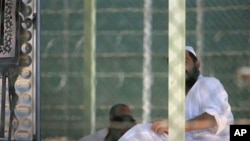The anti-secrecy group WikiLeaks has released another trove of U.S. classified documents, this time dealing with the military’s detention facility for suspected terrorists at Guantanamo Bay, Cuba.
The first batch of reports, reported by several U.S. and foreign news outlets, deal with information provided by the detainees under interrogation and the future threat that they might pose. The military also singles out links to two allied intelligence agencies as possible terrorist indicators.
Most of the latest published WikiLeaks documents are what might be called detainee personnel files. Labeled "Secret-Noforn" - meaning not to be shared with foreign intelligence agencies - they are primarily evaluations of who might be a future terrorist threat. But there are also some other supporting documents, including one potentially explosive one regarding terrorist support groups.
One lengthy document, titled "Matrix of Threat Indicators for Enemy Combatants," provides guidance to interrogators and other officials on what signs to look for in a potential terrorist. A list of organizations labeled "associate forces" of al-Qaida or the Taliban includes Pakistan’s Inter-Services Intelligence directorate, the ISI, and Yemen intelligence. Both have received millions of dollars in U.S. aid to fight terrorism.
The ISI has long been criticized in some quarters for alleged links to the Afghan Taliban, but Pakistan has repeatedly denied the charge. Parts of Yemen, which has recently been rocked by political instability, have been havens for al-Qaida in the Arabian Peninsula, an offshoot of the original group.
In the files, details are given of the information gleaned from interrogations of suspects interned at Guantanamo, including associates of al-Qaida leader Osama bin Laden.
Former CIA officer Michael Scheuer, who once headed the unit hunting bin Laden, says that from the documents, it appears that interrogators did not get so-called "actionable intelligence" - information that would lead to attacks against terrorist targets.
"Inevitably, when you talk to someone from al-Qaida or who is associated with al-Qaida, you can elicit information that’s very useful to help put the organization in context and discover how it works. Very seldom do you get any actionable intelligence. For the most part al-Qaida operatives are very proud to talk about their organization and what they’ve accomplished and where they see themselves in Islamic history. And from what I’ve read so far in these leaks that’s exactly the kind of discussion that they had with many of their interrogators," he said.
Shane Kadidal of the Center for Constitutional Rights says much of the information did not deal with al-Qaida or the Taliban at all. "A lot of the interrogations that took place over the years had nothing to do with 9-11 or terrorism. They were men who were held for years in order to get information about al-Jazeera’s operations or the Uzbek intelligence service the Bahraini royal family or how the Taliban conscripted people, even though the people being interrogated were folks who said they were involuntarily conscripted by the Taliban," he said.
But Scheuer says the interrogators nevertheless got useful information. He says the documents show that, contrary to a view voiced by then-CIA director George Tenet in 2002, bin Laden was not surprised by the U.S. response to the terrorist attack in the United States of Sept. 11, 2001. And, he adds, they also add to the portrait of bin Laden and his deputies.
"The other thing that’s clear, both before and after 9-11 is bin Laden is a very hands-on guy. Both he and [Ayman] al-Zawahiri and Khalid Sheikh Mohammad and the rest of them were very much peripatetic (moving around on foot). They were moving around the country, meeting with people, talking about plans, and generally running the organization in a very professional manner, it appears, anyway," he said.
Mark Denbeaux, head of the Seton Hall University Center for Policy and Research, says the documents serve as the basis for detainees' continued detention. The center has done extensive research on the Guantanamo detainees and the security implications. Denbeaux says most of the nearly 800 detainees who have been held at the facility since its opening in Jan. 2002 are either innocent or low-ranking foot soldiers.
"We now know what they claim is their classified basis for their detention. But in the cases that we have sampled overnight, I would say that nothing changes the fact that the profile, really, of the detainees who were there is a profile of low-level, not very significant hangers-on, if that, in various parts of Afghanistan and Pakistan," he said.
Abdul Bagi, a farmer, was picked up near Kandahar in February 2003. According to the documents, he was deemed to be a member of the Taliban and was designated an enemy combatant by a U.S. "combatant status review" in 2004. But, according to another document, he was assessed to be a low risk in May 2005. It noted he cannot read, cannot write except for his own name, and did not know what "jihad" means but believed it to be something carried out by soldiers and the Afghan government. It says he was picked up for wearing a green jacket like Taliban who had attacked U.S. forces.
Published reports say that after three years in captivity, he was flown back to Afghanistan in Feb. 2006.












